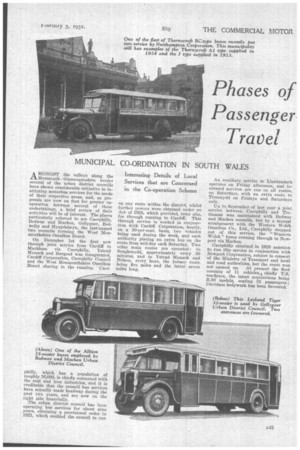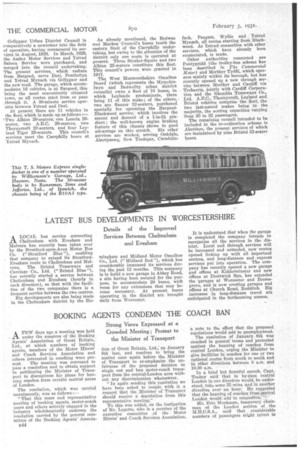Phases of Passenger Travel
Page 61

Page 62

If you've noticed an error in this article please click here to report it so we can fix it.
MUNICIPAL CO-ORDINATION IN SOUTH WALES
Interesting Details of Local Services that are Concerned in the Co-operation Scheme AMONGST the valleys along the Monmouth Glamorganshire border several of the urban district councils have shown considerable initiative in instituting motorbus services for the needs of their respective areas, and, as proposals are now on foot for greater cooperation between several of these undertakings, a brief review of their activities will be of interest. The places Particularly referred to are Caerphilly, Bedwas and Machen, Gellygaer, Bedwelty and Mynydslwyn, the last-named two councils forming the West Monmouthshire Omnibus Board.
On December 1st the first new through joint service from Cardiff to Markham via Caerphilly, Ystrad Mynach and Bargoed was inaugurated, Cardiff Corporation, Caerphilly Council and the West Monmouthshire Omnibus Board sharing in the running. Caer philly, which has a population of roughly 16,000, is chiefly concerned with the coal and iron industries, and it is creditable that the council bus services have actually made headway during the past two years, and are now on the right side financially.
The urban district council has been operating bug services for about nine years, obtaining a provisional order in 1921, which enabled the council to run
on any route within the district, whilst further powers were obtained tinder an Act of 1928, which provided, inter alia, for through running to Cardiff. This through service is worked in conjunction with Cardiff Corporation, hourly, on a 50-per-eent. basis, two Vehicles being used during the week, and each anthority placing an extra bus on the route from mid-day each Saturday. Two other main routes are operated : to Senghenydd, approximately every 80 minutes, and to Ystrad Mynach and Nelson, every hour, the former route being five miles and the latter seven miles long.
An auxiliary service to Lianbradach operates on Friday afternoon, and increased services are run on all routes, on Saturdays, with an extra route to Trecenydd on Fridays and Saturdays only.
Uu to September of last year a joint service between Caerphilly and Trethomas was maintained with Bedwas and Machen councils, but by a mutual arrangement with the Western Welsh Omnibus Co., Ltd., Caerphilly dropped out of this service, the " Western Welsh" buses running through to Newport via Machen.
Caerphilly obtained in 1928 sanction to run this service in conjunction with Newport Corporation, subject to consent of the Ministry of Transport and local and road authorities, but the route was not opened up. At present the fleet consists of 11 vehicles,i chiefly T.S. machines, the latest acquisitions being B.10 models, seating 82 passengers ; Davidson bodywork has been favoured. Cellygaer Urban District Council is comparatively a newcomer into the field of operation, having commenced its services in August, 1928. In March, 1929, the Amber Motor Services and Ystrad Saloon Service were purchased, and merged into the council undertaking. The present service; which ' radiate from Bargoed, serve Den, Pontlottyn and Ystrad Mynach via Gellygaer and the new road. The garage, which accommodates 16 vehicles, is at Bargoed, this being the most conveniently situated town, as all routes start from or pass • through it. A 30-minute service operates between Ystrad and Den.
At present there are 11 vehicles in the fleet, which is made up as follows Two Albion 20-seaters; one Lancia, 26seater, two A.E.C. 26-seaters, two Thornycroft 20-seaters, and four Ley land Tiger 29-seaters. This council's services meet the Caerphilly buses at Ystrad Mynach. As already mentioned, the Bedwas and Machen Council's buses touch the eastern limit of the Caerphilly undertaking, but owing to the situation of the district only one route is operated at present. Three Straker-Squire and two Albion 25-seaters constitute this fleet. This council's powers were granted in 1917.
The West Monmouthshire Omnibus Board (which represents the Mynydyslwyn and Dedwellty urban district councils) owns a fleet of 16 buses, in which Leylands predominate, there being 11 of this make ; of the others, two are Saurer 32-seaters, purchased specially for operating the BargoedBlackwood service, which involves the ascent and descent of a 1-in-3i gradient; the well-known engine braking feature of this chassis shows to good advantage on this stretch. Six other Services are worked, serving Oakdale, Abertysswg„ New Tredegar, Cwmfelin
fach, Pengam, Wyllie and Ystrad Mynach, all routes starting from Blackwood. At Ystrad connection with other services, which have already been enumerated, is made.
Other authorities concerned are Pontypridd (the trolley-bus scheme has been described in The Commercial Motor) and Merthyr Tydfil, which operates mainly within its borough, but has recently opened up a new through service between Merthyr and Cardiff via Treharris, jointly with Cardiff Corporation and the Rhondda Tramways Co., Ltd. A.E.C., Thornycroft, Leyland and Bristol vehicles comprise the fleet, the two last-named makes being in the majority, the seating capacities varying from 20 to 32 passengers.
The remaining council intended to be included in the co-ordination scheme is Aberdare, the present services of which are maintained by nine Bristol 32-seater buses.




































































































